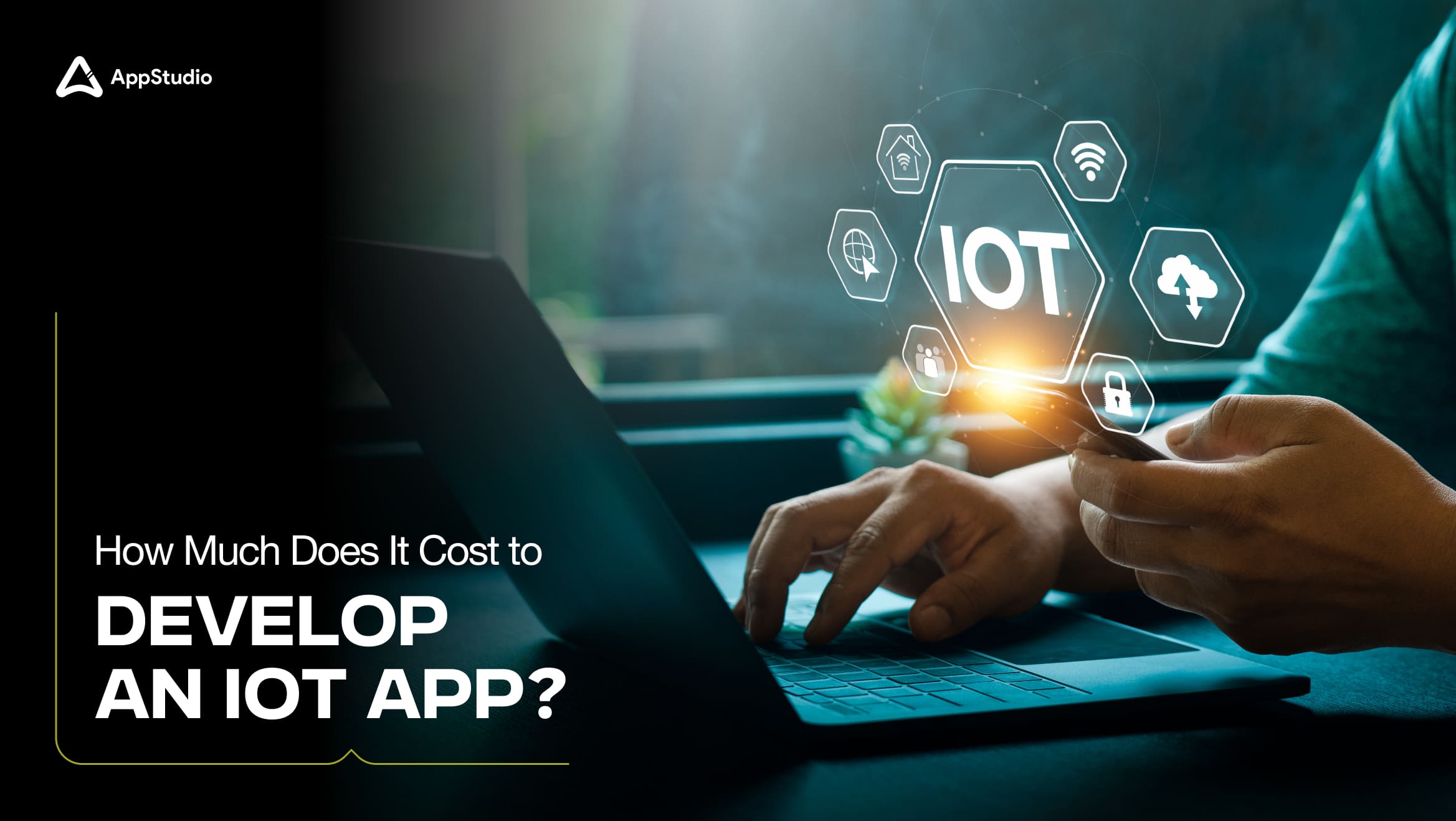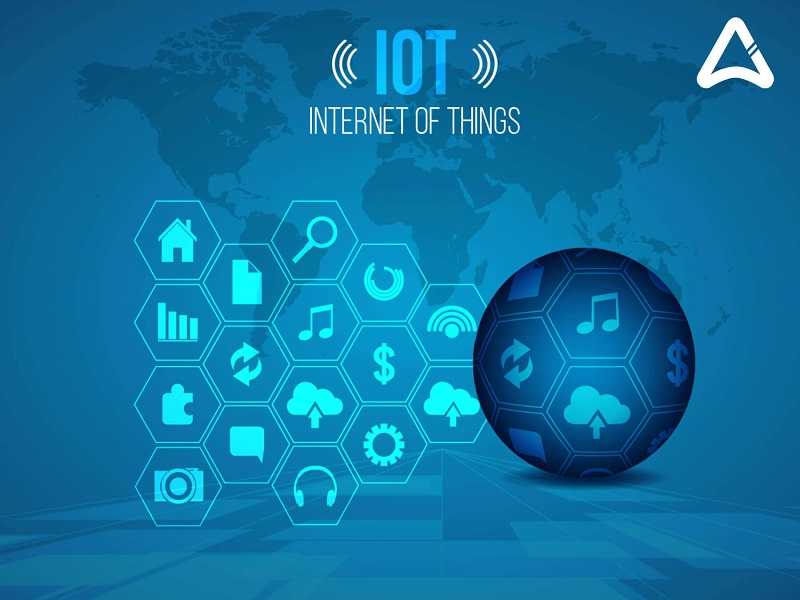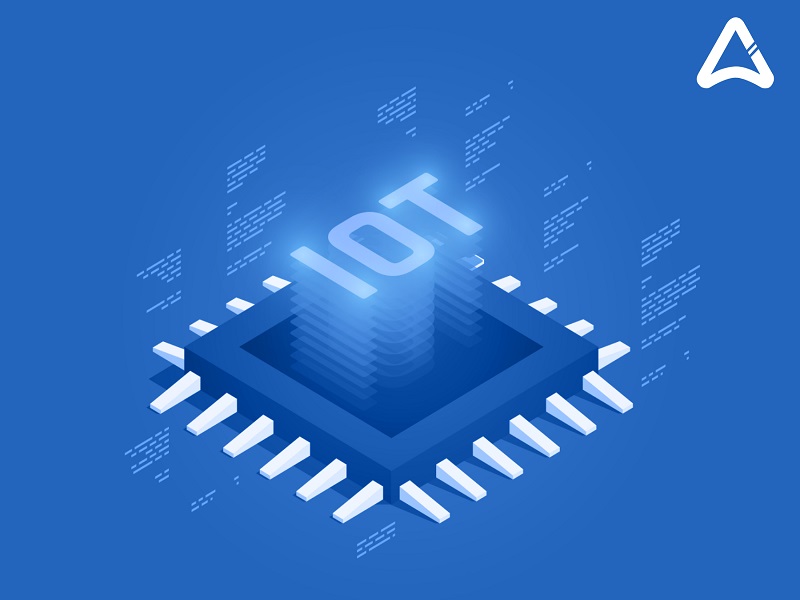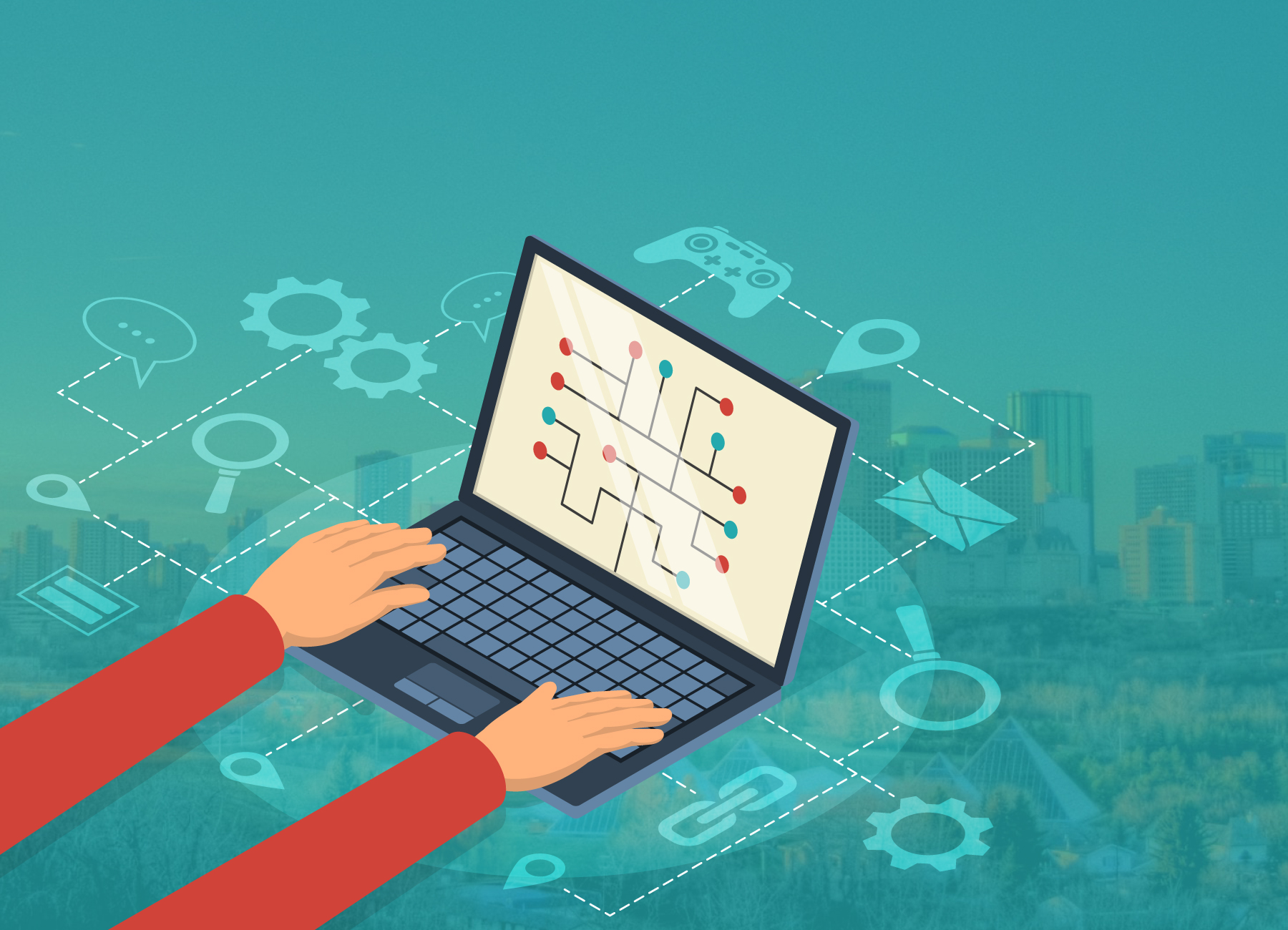The Internet of Things (IoT) has evolved beyond being just a buzzword; it’s now a transformative force for businesses across industries. Whether it’s smart homes, healthcare innovations, industrial automation, or logistics, IoT has reshaped how we engage with technology. It’s not merely about linking devices but building an interconnected ecosystem that drives convenience, efficiency, and smarter decision-making.
Planning to develop an IoT app in 2025? The first question on your mind is probably: “What’s the cost?” While there’s no universal answer, understanding the factors that affect IoT development costs can help you make informed decisions. This guide will break down the key elements influencing IoT app development costs and share tips to ensure your investment is worthwhile.
According to McKinsey Global Institute, IoT technology could deliver an economic impact ranging from $3.9 trillion to $11.1 trillion annually by 2025! Industries like manufacturing, healthcare, and transportation are leading this adoption. The opportunity is immense, but so is the competition. Creating an IoT app isn’t just an advantage anymore—it’s essential to stay ahead in the game.
That said, IoT app development is costly, and costs can vary widely depending on multiple factors. Don’t worry—this blog will break it all down for you and serve as your ultimate guide.
Related reading: IoT App Development: A Comprehensive Guide
Understanding IoT App Development Costs
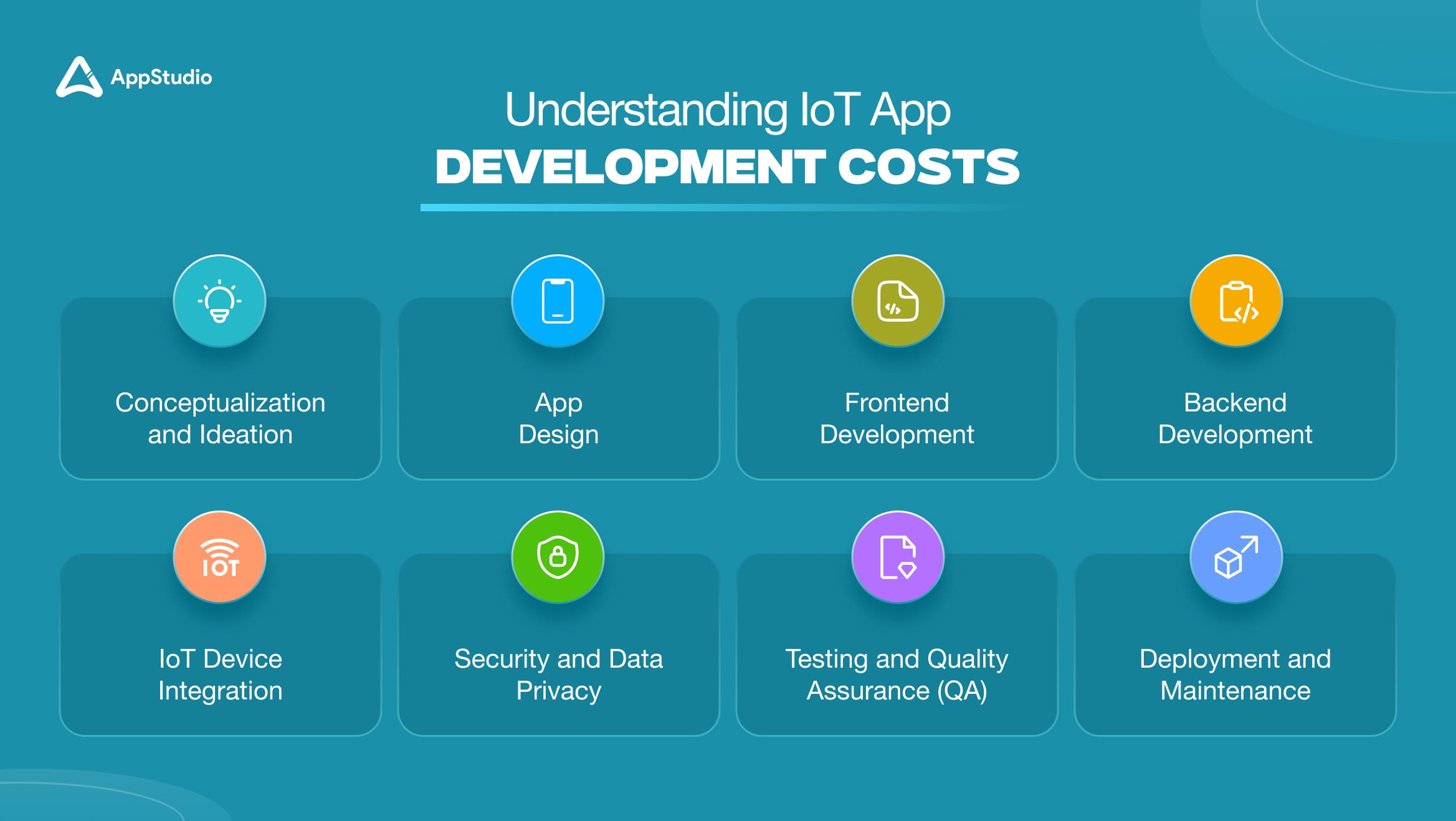
Developing an IoT app is no small feat—it’s about creating a seamless connection between the physical and digital worlds, enabling devices to communicate through the internet. Each stage of development adds to the overall IoT app development cost, and understanding these stages can help you plan your investment wisely.
1. Conceptualization and Ideation:
This is where your IoT app takes shape. Defining the purpose, audience, and features involves brainstorming, market research, and problem-solving. Costs in this stage are tied to hiring consultants, market researchers, and strategists who refine your app’s vision.
2. App Design:
Designing an intuitive UI and UX is critical. Wireframes and prototypes visualize the app’s functionality. The costs here include the fees of graphic designers, UX/UI specialists, and tools for creating mockups.
3. Backend Development:
The app’s backbone includes server setup, database management, and integration with IoT devices. The IoT development cost at this stage depends on data complexity, device compatibility, and security measures, often requiring backend developers, database admins, and cloud services.
4. Frontend Development:
This stage focuses on the interface users interact with directly. Frontend developers ensure responsiveness and dynamic designs. Costs include hiring development experts, QA engineers, and testing tools.
5. IoT Device Integration:
Integrating IoT devices, sensors, and protocols is at the core of IoT app functionality. This phase demands hardware, firmware, and device compatibility testing specialists, adding to the overall expense.
6. Security and Data Privacy:
With IoT apps dealing with sensitive user data, robust security is a must. Encryption, authentication, and compliance measures are crucial. Costs involve hiring cybersecurity experts and using advanced security tools.
7. Testing and Quality Assurance (QA):
Ensuring the app’s performance, usability, and security requires extensive testing. From beta testing to fixing bugs, this stage includes QA engineers, compatibility testing, and testing tools.
8. Deployment and Maintenance:
Post-launch, maintaining the app’s performance, rolling out updates, and fixing bugs are ongoing expenses. This stage involves deployment specialists, app store fees, and regular maintenance costs.
Related reading: Top 10 Best IoT Programming Languages
Top 5 Platforms for IoT App Development Cost and Its Features
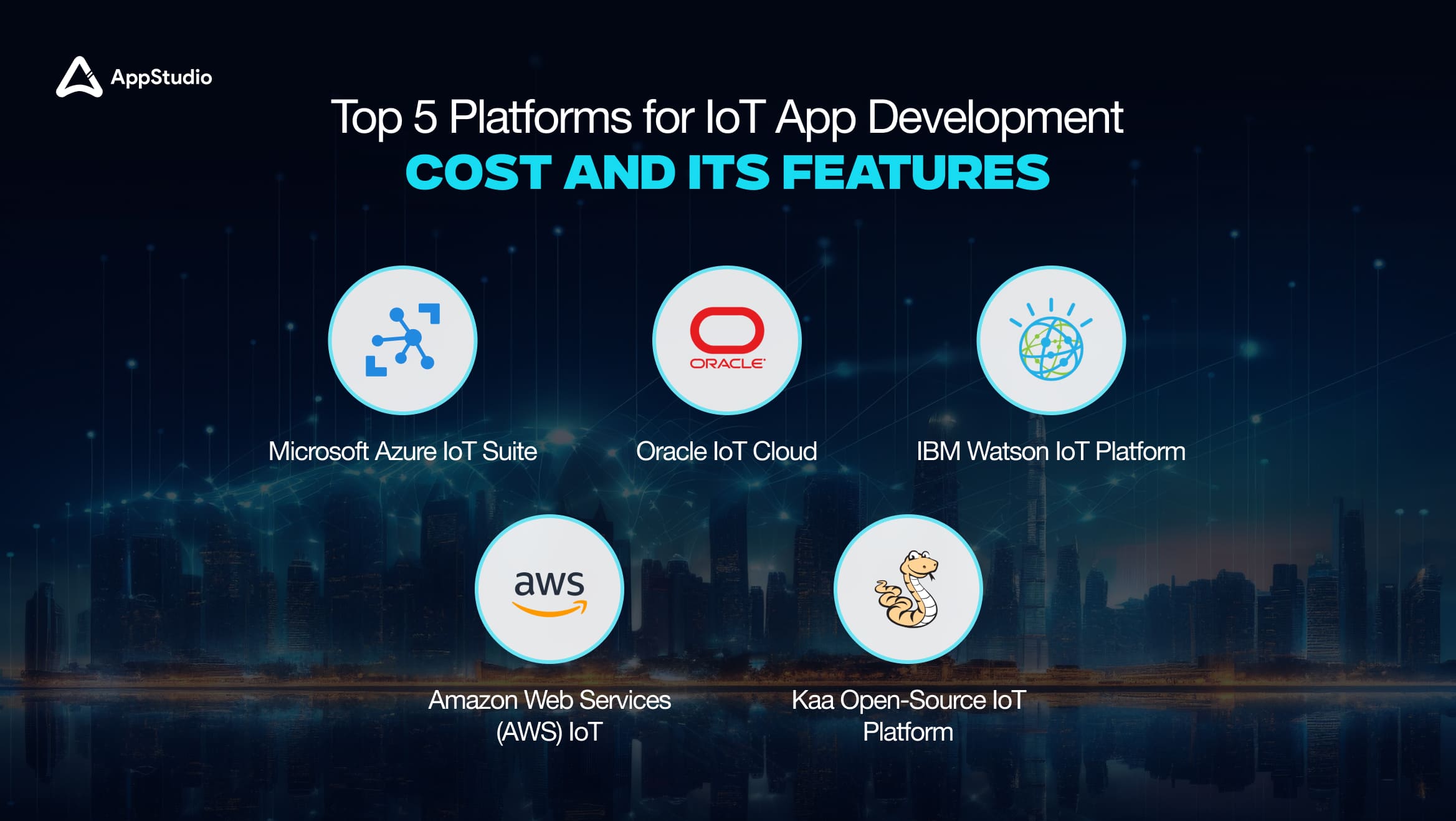
When exploring IoT app development, choosing the right platform is crucial. Let’s look at some of the leading platforms, their features, and how they impact the cost of IoT software development.
1.Microsoft Azure IoT Suite
The Azure IoT Suite is a robust collection of services, including Stream Analytics, IoT Hub, Machine Learning, Power BI, and Notification Hubs. It supports various operating systems and devices, enabling advanced data visualization and analysis.
The platform’s scalability makes it a favorite for many IoT development providers, helping businesses transition seamlessly from proof of concept (POC) to large-scale deployments.
2.IBM Watson IoT Platform
IBM Watson IoT secures multiple connected devices while providing developers access to tools for data management, instant analysis, connectivity, and risk mitigation.
It collects real-time data from devices, manages and configures it, and integrates it with other services. This platform ensures that IoT solutions remain secure, reliable, and efficient, safeguarding the integrity of connected ecosystems.
3.Amazon Web Services (AWS) IoT
AWS IoT is among the most popular platforms due to its cost-effective cloud infrastructure and unmatched reliability. Its scalability makes it ideal for businesses of all sizes, allowing IoT developers to optimize costs without compromising performance.
The flexibility offered by AWS IoT supports diverse business needs, ensuring a smooth and affordable development experience.
4.Oracle IoT Cloud
Oracle’s IoT platform delivers flexible network configurations, real-time data streaming, command-and-control features, and virtual device simulations.
It safely gathers data from various devices, leveraging technical abstraction for efficient processing. Integrated with Oracle PaaS and on-premise applications, this platform offers cutting-edge analytics using big data.
5.Kaa Open-Source IoT Platform
Kaa provides an unparalleled development experience for creating end-to-end IoT solutions, smart products, and connected apps. Its rich toolkit is highly customizable for different business applications, making it an excellent choice for those working with tight budgets.
Kaa simplifies hardware integration, making it easier for developers to create versatile IoT solutions at a lower IoT development cost.
IoT technology offers immense opportunities for businesses across industries. Whether you choose Azure, IBM Watson, AWS, Oracle, or Kaa, the ultimate goal is to deliver a connected ecosystem that drives high revenue.
However, IoT app development requires investment, and understanding the IoT development cost is essential. To ensure success, selecting a platform that aligns with your goals and budget is crucial, helping you maximize returns and drive your business’s growth.
Related reading: what is an IoT Platform? How is IoT used in the Business?
Top 5 IoT Applications with Examples
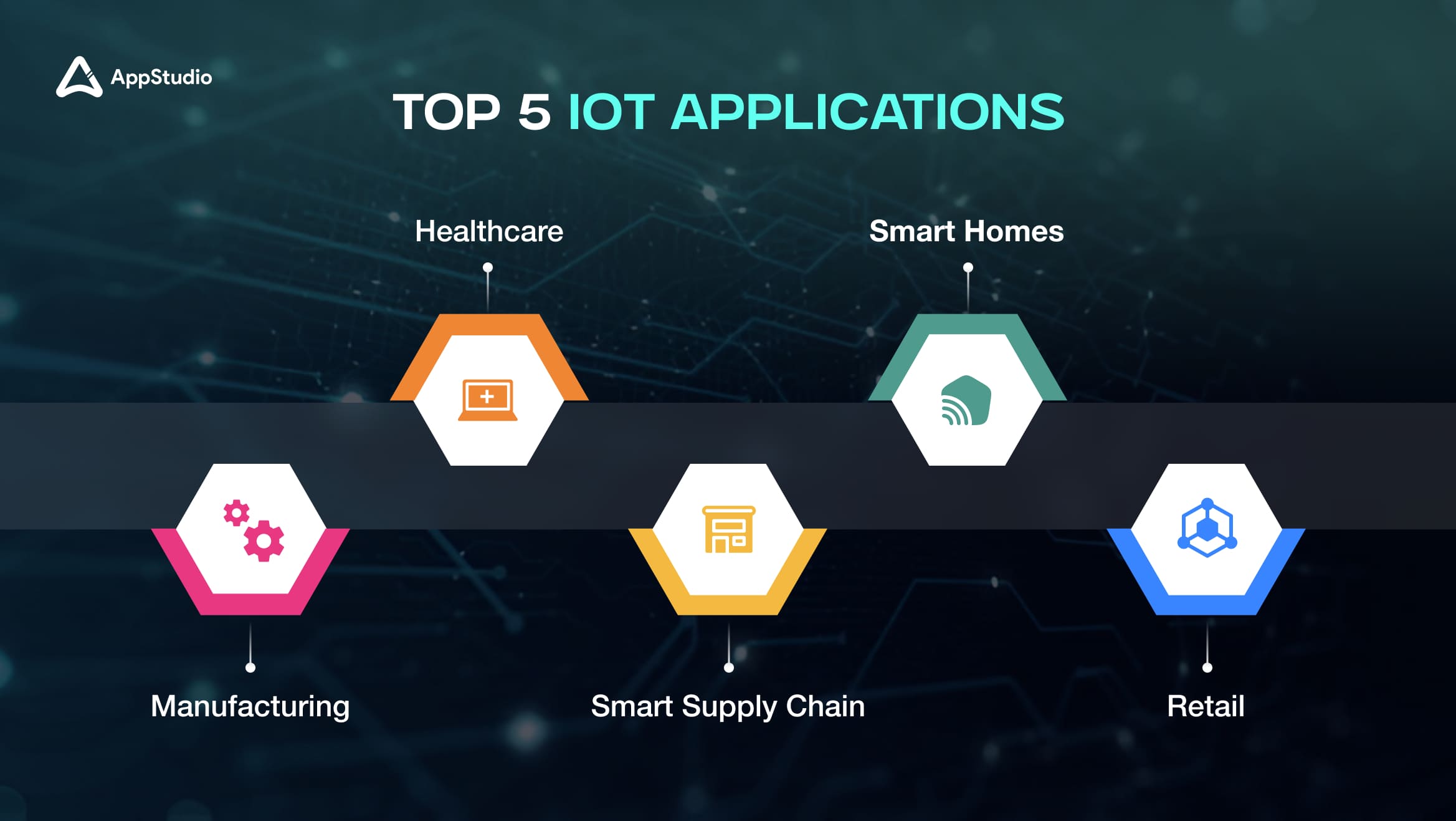
With the integration of technologies like Artificial intelligence and Machine learning, IoT has become a powerful tool for businesses to analyze data, enhance operations, and make informed decisions. Let’s explore six exciting IoT app development use cases and understand how they’re transforming industries—and why understanding IoT development cost is crucial for businesses.
1.Manufacturing
IoT has become a cornerstone of the manufacturing industry, enabling seamless Machine-to-Machine (M2M) communication. It streamlines processes, tracks operations in real-time, and enhances efficiency. By combining IoT with Augmented Reality (AR), manufacturers gain detailed insights into equipment status, fuel levels, and maintenance needs.
Examples, include digital quality control systems, equipment monitoring apps, and asset management tools—all powered by IoT. These solutions improve productivity while cutting downtime, showcasing the value of IoT app development costs.
2.Healthcare
IoT is revolutionizing the healthcare industry, enabling better patient care through advanced monitoring and diagnostics. Applications include patient health tracking, temperature and environmental monitoring for medical products, and real-time diagnostics.
A notable example, is the Ochsner Health System, which integrates IoT-enabled devices with Electronic Health Records (EHRs). Devices like wireless scales and cuffs collect patient data and send it to their health records via smartphones. Doctors and health coaches then use this data to monitor health remotely and provide proactive care.
3.Retail
Retail is another sector thriving on IoT-driven innovations. IoT enables supply chain management, personalized shopping experiences, and data-driven inventory optimization. It extends beyond traditional retail to hospitality, restaurants, and other businesses, offering solutions like location-based services and customer insights.
For example, retailers use IoT to tailor product collections based on customer location, preferences, and purchasing behavior. This connectivity not only improves operations but also enhances customer satisfaction.
4.Smart Homes
The concept of smart homes remains one of the most popular applications of IoT. From monitoring electricity usage to managing security systems, IoT-powered solutions simplify daily life by reducing the need for manual intervention.
Smart home technologies allow users to detect motion, adjust lighting, set alarms, and more—all through interconnected devices. These solutions personalize home management and highlight the transformative potential of IoT software development.
A prime example, include smart thermostats like Nest or Ecobee, which learn user preferences and automatically adjust temperatures, reducing energy costs while enhancing comfort. Home security systems such as Ring or Arlo further demonstrate the potential of IoT by integrating smart doorbells, cameras, and motion detectors, which send real-time alerts to smartphones, ensuring safety and peace of mind for homeowners.
5.Smart Supply Chain
IoT is driving innovation in supply chain management by improving operational efficiency and boosting revenue. With applications in asset tracking, vendor management, inventory forecasting, and fleet connectivity, IoT is transforming logistics.
One key benefit is enabling customers to track product journeys, from production to delivery. This transparency builds trust and improves the overall customer experience, demonstrating how investments in IoT yield long-term value.
For instance, RFID-enabled asset tracking allows companies like Walmart to monitor inventory levels and product locations in real time, ensuring timely restocking and minimizing stockouts. Predictive maintenance systems, used by logistics giants like DHL, leverage IoT sensors to identify potential issues in delivery vehicles before they become critical, reducing downtime and repair costs. These innovations ensure seamless operations and improve overall efficiency.
As IoT adoption grows, understanding IoT app development costs becomes a necessity for the businesses aiming to thrive in this competitive space.
Related reading: How to Leverage AI in IoT App Development for Smarter Automation
Key Factors Influencing IoT App Development Cost
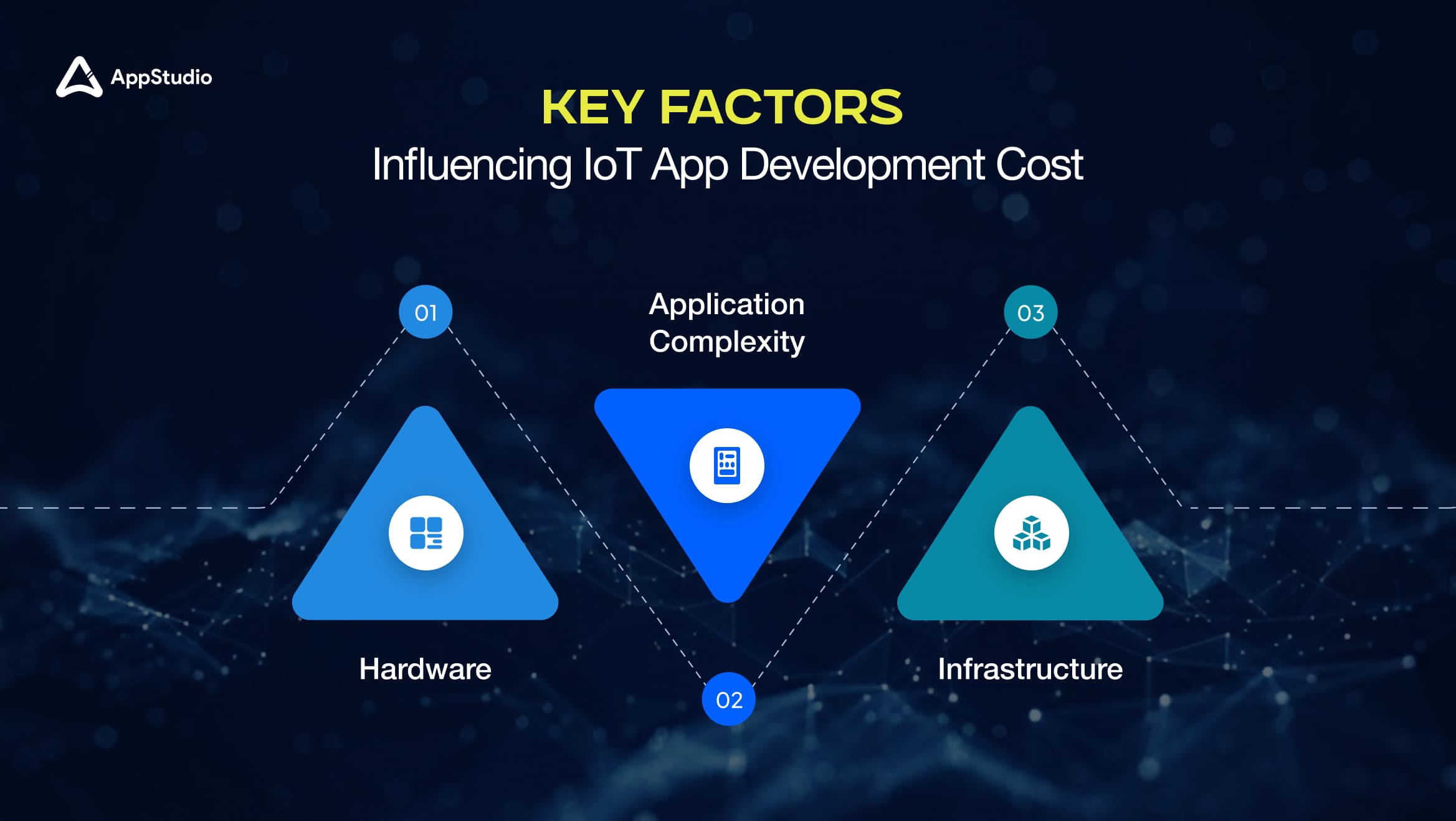
The IoT app development cost typically ranges from $20,000 to $60,000, depending on the complexity and type of IoT solution. For example, developing IoT systems for monitoring machines start at $25,000, while fully automating business operations can range between $50,000 and $80,000.
Let’s break down the key factors that influence these costs:
Hardware: The Backbone of IoT Development
Hardware accounts for 70–80% of the total cost to develop IoT products, with expenses depending on the solution’s complexity and requirements. Several stages in hardware design impact the overall cost:
- Analysis: Planning the budget, developing the concept, specifying technical requirements, and optimizing costs.
- Modeling: Designing PCB layouts and internal components with input from industrial engineers and designers.
- Prototyping: Building and testing initial hardware designs, often requiring multiple iterations to refine the product.
- Testing: Ensuring quality with climatic, electrical safety, and user-based tests before moving to pre-production models.
Infrastructure: The Foundation for IoT Ecosystems
A robust infrastructure is critical to maintain and monitor the entire IoT solution.
Infrastructure costs typically cover:
- Network: IoT solutions demand scalable, high-speed networks with low latency. Cellular networks, short-range wireless connections, and LPWAN solutions can increase costs.
- Middleware: When integrating third-party devices, middleware connects various IoT components, often adding to the development expense.
- Cloud-Based Infrastructure: Cloud solutions store and refine raw data into actionable insights. While essential, solutions from platforms like Amazon, Microsoft, or Intel PaaS can significantly raise the IoT development cost.
Application Complexity: Driving Development Hours
The development difficulty of IoT apps directly affects costs. Applications can be categorized as Simple, Mediocre, or Complex:
- Simple Applications: These apps, like custom trackers, require up to 500 man-hours and essential programming tools for real-time sensor data rendering.
- Mediocre Applications: Apps with BLE capabilities for managing connected devices or visualizing data take around 1,000 man-hours.
- Complex Applications: Enterprise-grade IoT apps with features like Bluetooth-integrated radiation monitoring, cloud servers, AI implementation, and advanced security can take 2,000+ man-hours to build.
Additional Factors Influencing Costs
Other considerations that impact the cost of developing IoT products include:
- App type (e.g., monitoring, automation, or analytics).
- Complexity of app functionality.
- Number and type of connected devices.
- Location of the development team.
- Technologies and features integrated into the app.
Understanding these factors will help you estimate the budget required for IoT development.
Challenges in IoT App Development and Their Solutions
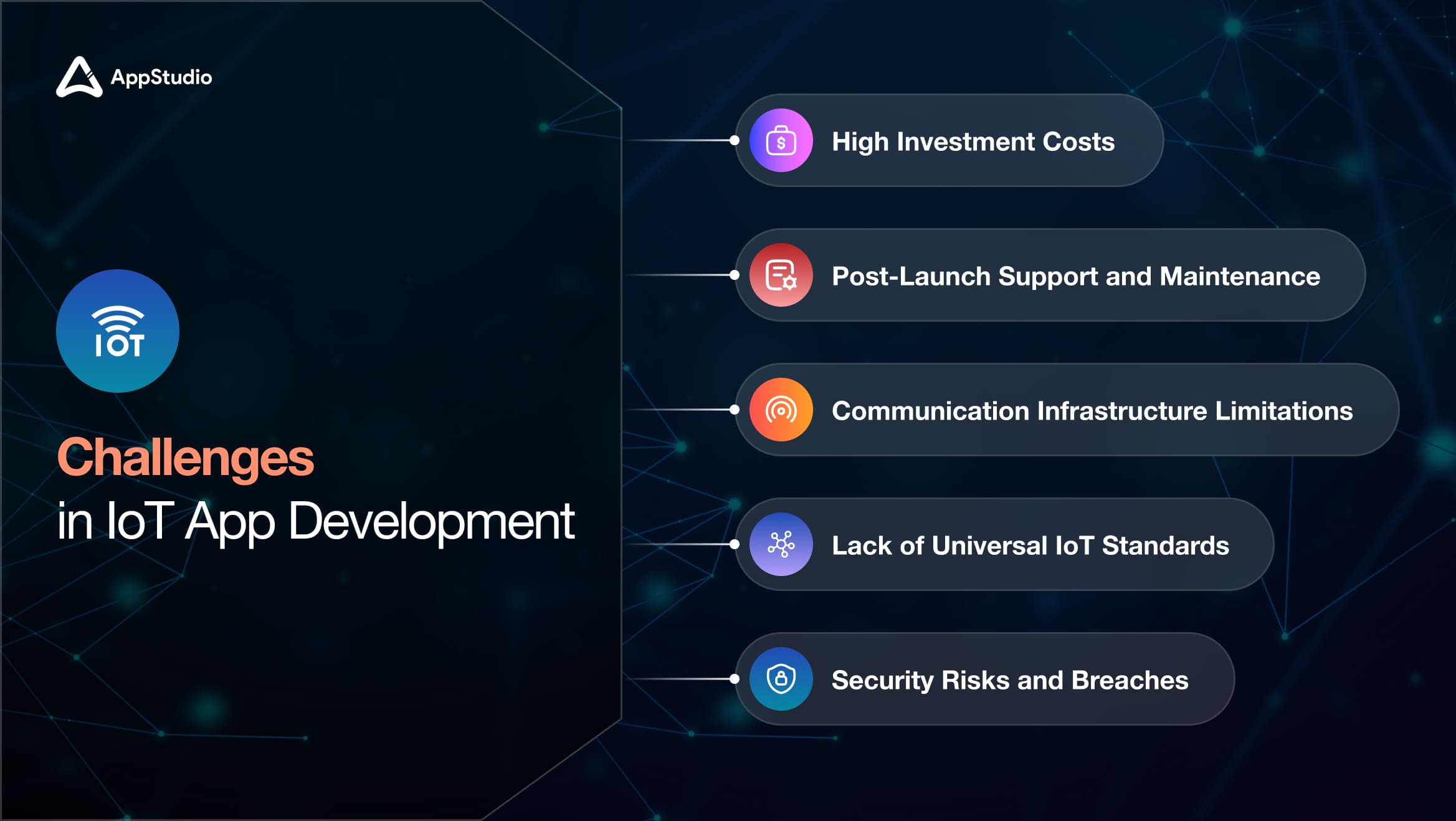
Developing IoT applications can be complex and riddled with obstacles. Here’s a detailed look at the key challenges you might encounter and how to overcome them:
High Investment Costs
The cost of IoT app development can be a significant challenge for businesses. It’s advisable to start with smaller-scale IoT implementations to manage expenses, focusing on specific milestones with reasonable budgets.
Gradually rolling out phases can help control costs effectively. Also, leveraging public infrastructure and SaaS solutions can further reduce expenses, making development more accessible.
Security Risks and Breaches
Security remains one of the most pressing concerns in IoT software development. Since IoT ecosystems rely on constant internet connectivity, hackers often target them. Addressing security vulnerabilities involves focusing on three critical stages of data management:
- Data at Rest: Encrypting data stored in the cloud or applications using a combination of hardware and software ensures robust protection.
- Data in Use: Securing actively used data depends heavily on strong authentication processes. This is often the most challenging stage to safeguard.
- Data in Transit : Encrypting data during transmission and decoupling action data from information-only data can minimize vulnerabilities. Enabling devices to generate and discard measurement data (“fire and forget”) further strengthens security.
Lack of Universal IoT Standards
One major hurdle in IoT app development is the need for universal standards. While organizations like IEEE and the Open Connectivity Foundation are working to establish a unified framework, businesses must navigate the existing fragmentation in the meantime. Patience and adaptability are essential until universal IoT standards become widely adopted.
Communication Infrastructure Limitations
Creating an IoT solution that works seamlessly across all geographical locations is challenging due to inconsistent network coverage. While cellular gateways provide a promising solution, they may not be reliable in areas with poor reception. To address this, businesses can utilize LTE-M and LTE-NB technologies, which enhance coverage by leveraging existing cellular towers without requiring extensive infrastructure investments.
Post-Launch Support and Maintenance
The process doesn’t end after deployment. Maintaining and updating IoT solutions to incorporate the latest features and technologies is essential for long-term success. However, this can add to the IoT app development cost.
The best way to address this challenge is to partner with an experienced IoT development company. Such companies provide cost-efficient, high-quality tools and services, ensuring seamless post-launch support and regular updates.
Related reading: Benefits of IoT App Development for Industrial Automation
How AppStudio Can Optimize Your IoT App Development Costs
When it comes to IoT app development, we at AppStudio focus on offering a comprehensive range of services designed to guide you through every phase of the process. From the initial planning stages to post-launch optimization, our expertise ensures that your IoT application is secure, scalable, and efficient. We work closely with you to implement features that connect devices seamlessly, optimize data collection, and improve the overall user experience.
Our IoT development approach involves integrating cloud services, utilizing real-time data processing, and incorporating advanced analytics. This enables your business to make data-driven decisions while maintaining seamless connectivity. Furthermore, we enhance your application by combining IoT with cutting-edge technologies like AI and machine learning, boosting automation and operational efficiency.
The user experience is just as important as functionality. That’s why we focus on creating intuitive, easy-to-navigate designs that foster better engagement and adoption. By collaborating between our development and design teams, we ensure your IoT solutions work flawlessly and deliver an optimized experience that users will appreciate.
Contact us today to learn how we can assist with the cost of your IoT app development and tailor a solution that perfectly aligns with your business objectives!
Frequently Asked Questions
AppStudio streamlines the development process with pre-built templates and a visual interface, enabling faster prototyping and deployment of IoT apps. We integrate various IoT protocols, saving developers time from manually configuring device communication. Also, its low-code platform reduces the need for extensive coding, which cuts down on development costs and time, allowing developers to focus more on custom features and innovations.
AppStudio offers real-time data synchronization, cloud service integration, and robust support for various IoT devices. It provides seamless connectivity between mobile apps and IoT devices via protocols like Bluetooth, Zigbee, and Wi-Fi. Its low-code environment helps developers create IoT applications without deep programming expertise, making it suitable for experienced developers and those new to the IoT space.
AppStudio supports integration with multiple IoT devices, including sensors and actuators, using standard communication protocols. Through API and SDK integrations, it ensures real-time data synchronization between the hardware and the app. This allows for live tracking of device status, sensor data, and events, which is critical in many IoT applications, from smart homes to industrial monitoring.
The cost of developing an IoT app can vary widely, typically ranging from $20,000 to $60,000. The final price depends on various factors such as the app’s specific features, the devices it needs to connect to, and the expertise of the development team. To determine what best suits your needs and budget, contact AppStudio’s experts today for personalized advice and a detailed cost estimate.
IoT app development differs in its focus on hardware and real-time communication. While mobile app development focuses on user interfaces and interactions on smartphones, IoT apps integrate deeply with physical devices and require more attention to data synchronization, network reliability, and hardware compatibility. IoT app developers also need to handle issues like data security, device management, and continuous monitoring, which are less prevalent in traditional app development.
Common programming languages for IoT app development include Python, JavaScript, Java, C, and C++. These languages are chosen for their flexibility, efficiency in handling data, and compatibility with various IoT devices and platforms.
